Our first Australian animal sighting was a bird, an ibis. Since this one was new to us after seeing scarlet ibises in the US, we chased the birds through Sydney’s Royal Botanic Park to get pictures. Meanwhile, when we asked the locals what they were, one lady said, “Oh, they’re just pists” (rhymes with fists). It took a minute to realize she was saying they were “pests.” We should have remembered that earlier a waitress had said, “Have this one; it’s bitter.” Of course she was saying it was “better.” The Australian accent is such a treat.

We watched an ibis standing on top of a full trash can and reaching to pull a French fry out with his long beak. He was surrounded by seagulls. Before he could eat the fry, the gulls would swoop in and take it away.
Up in a tree in the Rocks area of Sydney we saw a colorful bird that we thought was a lone escaped parrot. He grabbed a sugar packet from a tabletop and took it to a tree branch to eat it. When he finished, he flew back for another one. We found out it’s a rainbow lorikeet, very common in this part of Australia.
Not as colorful, but much louder, are the screeching, swooping little corellas. They look a lot like sulphur-crested cockatoos, but don’t have the yellow crown.
And another parrot variety, a galah or rose-crested cockatoo showed up in several spots. These were much quieter than the white corellas.
The magpies we see in Australia are very similar to those in New Zealand.
Australian pelicans are quite large, with wingspan of up to eight feet. Their bills are the longest of any living birds. Although they primarily eat fish, they may also eat birds. (Thanks, wikipedia!)
Pelican is also Aussie slang for idiot. In fact, you can probably call someone a birdbrain with any bird name. That’s true in the US, too: loon, turkey. Speaking of turkeys, Noosa is overrun with Australian brush-turkeys. They are protected here and walk up and down the main residential streets. They build large mounds to incubate their eggs.
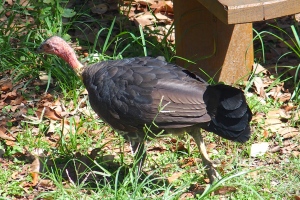
Australian brush-turkeys look like the “birds” on Grandpa Bach’s farm in Michigan, but apparently are not related.
We wouldn’t normally take photos of pigeons; they’re rather plain. But here in Australia they’re special.
Did you see the Jack Black/Owen Wilson/Steve Martin movie, The Big Year? We’re on our own quest for sightings of hundreds of bird species. (We, meaning anyone reading too. You’re stuck with it.)
Another bird, sort of. It’s a flying fox, an Australian megabat (actually a mammal). We watched hundreds of these swoop in to feed on a single tree in Noosaville very close to the lorikeet tree. Listen to the cicadas in the background.
Little Bay near Southwest Rocks was a virtual zoo. First we saw—and heard—kookaburras. Their heads are so big! That must help them achieve their unusually loud laughing birdsong. A local woman explained that one young bird with a less melodious call was just learning to laugh. She came to the bay every day to hear his progress.
Do you remember this song? Click the title for the melody.
The Kookaburra Song (written by Marion Sinclair, 1932)
Kookaburra sits on the old gum tree,
Merry merry king of the bush is he.
Laugh, Kookaburra, laugh, Kookaburra,
Gay your life must be!
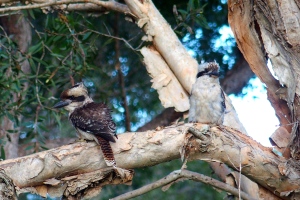
Here are two kooks in a gum (eucalyptus) tree. The bark strips off, leaving the white underbody on the tree. Some call it a ghost gum.
At the shore were many pieces of flotsam and jetsam, things that looked like Styrofoam, maybe pieces of a damaged boat. They even felt like heavy foam when we pushed a thumbnail into them. Our local kookaburra lady explained that they were, in fact, cuttlefish (like squid).
We almost left the area without seeing the other wildlife resting in the shade. They had deer-like heads, but weren’t deer! We were seeing kangaroos in the wild.
As we got closer and closer to the roos, our local nature lady approached us to provide some helpful advice. It turns out that kangaroos will attack when they think they’re threatened and Michael was getting too close for comfort. The kangaroos have short, skinny front legs—not too dangerous-looking—in fact, they look like atrophied limbs. But their hind legs are powerful, thick, strong, and sharp-clawed. The amazing thing is that when fighting, the kangaroos can lean back on its heavy tail and use its hind legs to strike out. With the strong limbs and sharp nails, they can maul attackers or pseudo-attackers, sometimes with fatal outcomes. OK, we’ll back off.
Did you know: A kangaroo is pregnant for only three to six weeks, but the baby is born and stays inside the pouch for up to 450 days. The mom can give birth to up to four babies at a time. Not sure how that works! One looks like too many.
Later at Tewantin Golf Course in Noosa, Michael saw an interesting reaction to his presence.
Oh-oh! Michael is a threat.
It’s like childbirth in reverse, getting worse every day as the baby roo gets bigger.
Mama Roo is not happy. Note the bared teeth. Is it because Michael is a threat or because her pouch is stretched beyond pain?
Australia has some of the most poisonous creatures on the planet. Here on the beach of Alexandria Bay we saw two naked men and two naked ladies (not that they’re poisonous, just distracting) and two large jellyfish. This one is six inches in diameter, not as dangerous as the bluebottles we saw earlier. Check out this video of a giant swarm of jellyfish on the Gold Coast earlier this year.
We had very large spiders just outside our airbnb. We didn’t bother them to ask how poisonous they were, so they didn’t bite us.
While walking along one trail from the beach we met a man with a stick who was inspecting the sand. He saw a trail he thought was from a goanna, a monitor lizard that can grow up to eight feet long! We didn’t notice anything like that on our way to the beach. He explained that the stick was for snakes—on the ground, along the trail, in the trees, probably flying through the air. Australians seem proud to say that of the 10 most poisonous snakes on the planet, they have eight. We didn’t see any snakes, but Michael found his own snake stick just in case.
No goannas, but we did see this water dragon on the Brisbane rainforest walk.

This water dragon was at the entrance to a littoral (coastal) rainforest. We found many practically underfoot.
And a poor little gecko missing his front foot.
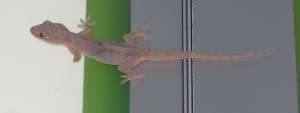
He was climbing on the menu at a smoothie shop. Fortunately, he didnt fall into the Vitamix, although he could have made it a protein shake.
We haven’t yet seen a koala, but there are koala signs all over. You’d think that car/koala collisions were as common in Australia as car/deer collisions in the US.
We saw plenty of painted koalas in Port Macquarie. For “Hello Koalas,” local artists painted koala statues just like the cows in Chicago, horses in Rochester, and deer in Canandaigua.
We have stiff necks from looking up in the trees for gray balls of fluff, but no luck. We found out that many native Australians have never spotted a koala in the wild.
So it’s on to the Lone Pine Koala Sanctuary in Brisbane where we are assured to have a koala sighting.



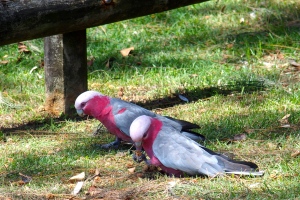
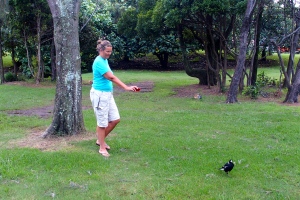
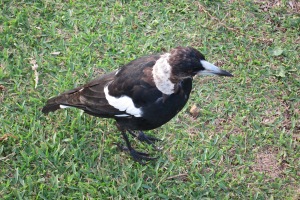



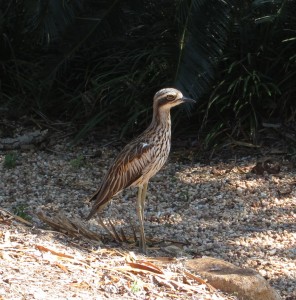



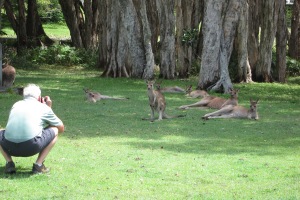






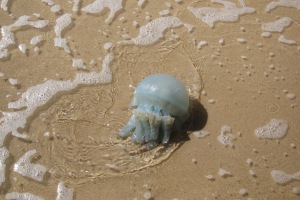


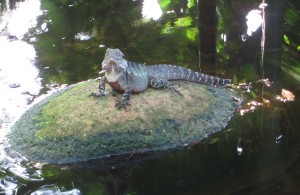


Very much enjoying your Australia photos. Reminiscing about our trip there and all the wonderful things we saw. Thanks for sharing.
LikeLike
Thanks, Betsy. What was your favorite part of your Australia trip? We still have a few more days to squeeze in anything we missed!
LikeLike
So I would call this the “Birds get no respect” section. Also, I want to think of a way to get the “…. looks like 2 kooks in a gum tree” simile into something I say soon.
LikeLike
Get a pack of Juicy Fruit. Grab Paul. Do a dual selfie from that nice tree in your backyard. “Looks like 2 kooks in a gum tree” is your caption.
LikeLike